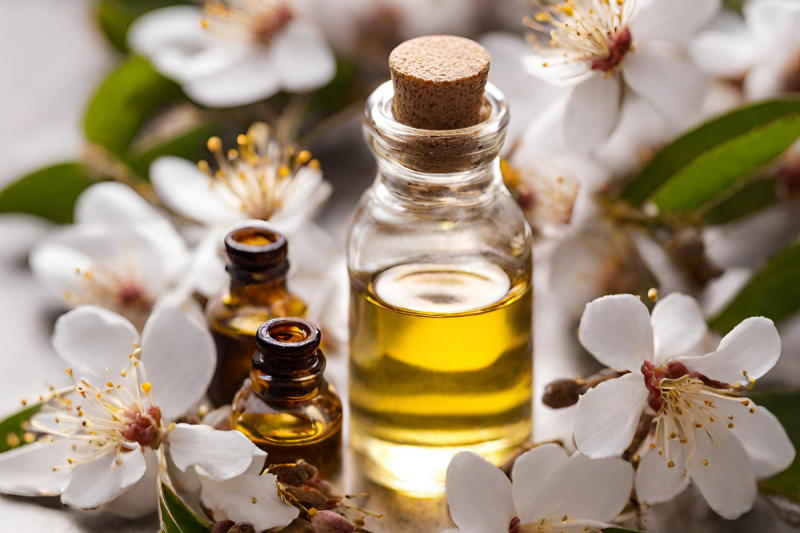Among the many compounds in mānuka oil, one powerful bioactive constituent stands out because of its ability to have more potent antimicrobial activity against gram-positive bacteria: triketones.
The Chemistry Behind Mānuka Oil
The mānuka plant is native to New Zealand and Australia and has gained popularity for its remarkable therapeutic properties.
Mānuka essential oil, scientifically known as Leptospermum scoparium, is extracted through steam distillation of the mānuka plant’s leaves and twigs. This process yields an oil containing over 100 individual chemical components, encompassing a wide range of volatile, semi-volatile, and slightly volatile compounds.
The primary constituents of mānuka essential oil, similar to many other essential oils, belong to a class of compounds known as terpenoids. Terpenoids consist of molecules called monoterpenes (C10 terpenoids) and sesquiterpenes (C15 terpenoids), which include various oxygenated derivatives such as aldehydes, alcohols, and esters. These terpenoids form the majority of the chemical components found in Mānuka essential oil and other essential oils.
What Are Triketones?
A triketone is a naturally occurring organic chemical compound found in nature. Triketones are known for their exceptional antimicrobial properties, which make them valuable against harmful bacteria, fungi, and inflammation.
Mānuka essential oil’s distinctive chemical composition sets it apart from other essential oils. In terms of concentration, the most abundant triketones found in mānuka essential oil are sesquiterpenes, E-calamenene, leptospermone and isoleptospermone.
- Sesquiterpenes are less volatile triketones found in mānuka oil, resulting in a milder and more pleasant fragrance.
- E-calamenene is a key compound responsible for the unique spicy yet sweet fragrance that characterises mānuka essential oil, as supported by experimental research showing its effectiveness in creating a relaxing environment.
- Leptospermone, a potent triketone known for its anti-inflammatory effects, plays a crucial role in mānuka oil’s ability to soothe irritated skin and reduce redness. This triketone also possesses surface-cleansing properties, suggesting its potential usefulness in cleaning applications.
- Isoleptospermone is another triketone present in mānuka oil, contributing to its antioxidant properties. This compound helps combat free radicals and supports overall skin health.
Are All Mānuka Oils the Same?
Scientific evidence demonstrates that the proportion of triketones present in the oil primarily determines the antimicrobial effectiveness of mānuka oil.
New Zealand’s mānuka oil can be categorised into three main types based on its chemical composition and geographical distribution:
- East Cape and Marlborough Sounds Region: Mānuka oil is characterised by its high triketone content in these regions.
- Far North Region: Mānuka oil from the far north of New Zealand is rich in pinene.
- Rest of New Zealand: Mānuka oil from the remaining areas of New Zealand contains a mixture of sesquiterpenes.
The East Cape Mānuka Oil Difference

Mānuka oil sourced from the East Cape region of New Zealand has been scientifically demonstrated, through research conducted by the Cawthron Institute of New Zealand, to exhibit significantly higher antimicrobial effectiveness against gram-positive bacteria like Staphylococcus aureus (staph) and Streptococcus pyogenes (strep) when compared to Australian tea tree oil. This heightened efficacy is attributed to a specific class of organic chemical compounds known as Mānuka ß-triketones, naturally occurring in the oil and obtained through the distillation of Mānuka tree foliage.
Researchers conducted a study on oils obtained from 36 individual plants in the East Cape of New Zealand consistently exhibited a high triketone content, surpassing 20% in total triketones. Notably, there was minimal fluctuation in these triketone levels across different seasons, indicating a stable chemical composition in this specific geographical area.
In addition, an analysis of oils extracted from 261 individual mānuka plants, gathered from 87 different locations across New Zealand, revealed interesting findings. Specifically, the high triketone chemotype was primarily concentrated in the East Cape region. However, it’s noteworthy that oils with triketone levels of up to 20% were also discovered in the Marlborough Sounds area of the South Island. Additionally, cluster analysis identified different chemotypes localized in various regions of New Zealand, indicating distinct chemical profiles in different areas.
What is MßTK™?
The term “MβTK™” stands for natural Mānuka oil ßeta triketones. The MβTK™ quality mark is used to indicate the percentage of Mānuka β-triketones present in Mānuka oil.
The unique environmental conditions in New Zealand’s East Cape region have given rise to an extraordinary essential oil found in the leaves of the mānuka tree. Mānuka oil that contains exceptionally high concentrations of naturally occurring ß-triketones (MβTK™) is labeled with the MβTK™ quality mark.
This label serves as an assurance of the oil’s authenticity and quality.
Why are East Cape Mānuka ßeta Triketones Different?
The mānuka tree is distributed across New Zealand, but the concentration of MβTK™ content varies considerably depending on the location of plant harvesting.
In mānuka oil obtained from the East Cape of New Zealand, MβTK™ (Mānuka oil ßeta Triketones) is found at exceptionally high levels, occasionally exceeding 30%.
Why Choose a High Triketone Level?
The antimicrobial properties and benefits of Mānuka oil are directly related to the triketone levels present. Scientifically, East Cape Mānuka plants have been verified to contain high levels of Mānuka β-triketones. In laboratory studies conducted in vitro, MβTK™ has demonstrated effectiveness against a wide range of harmful bacteria, underlining its potency.
Mānuka Oil’s Benefits and Uses
Mānuka oil, with its triketone-rich composition, finds diverse applications in health and wellness.
- Acne Treatment – Mānuka oil’s antimicrobial properties make it an effective natural remedy for acne. It can help combat acne-causing bacteria and reduce inflammation, promoting clear and healthy skin.
- Aromatherapy – The soothing aroma of mānuka oil, coupled with its therapeutic benefits, makes it a valuable addition to aromatherapy sessions.
- Congestion Relief – When used in a steam inhalation or chest rub, mānuka oil can help relieve congestion associated with colds and respiratory infections.
- Hair Care – Mānuka oil can be incorporated into hair care routines to promote a healthy scalp and hair. Its antibacterial properties can help combat dandruff and scalp conditions, while its pleasant aroma adds to the overall experience.
- Mouthwash – A few drops of mānuka oil in water make an effective mouthwash that helps kill bacteria and refresh the mouth.
- Oral Health – Mānuka oil’s antibacterial qualities extend to oral care, which can be found in natural mouthwashes and toothpaste.
- Skin Care – Mānuka oil’s antibacterial and anti-inflammatory properties make it a potent ingredient in various skincare products, including creams, lotions, and serums.
- Wound Healing – The oil’s antiseptic qualities also facilitate wound healing. It can be applied topically to cuts, burns, and insect bites to accelerate the healing process.

